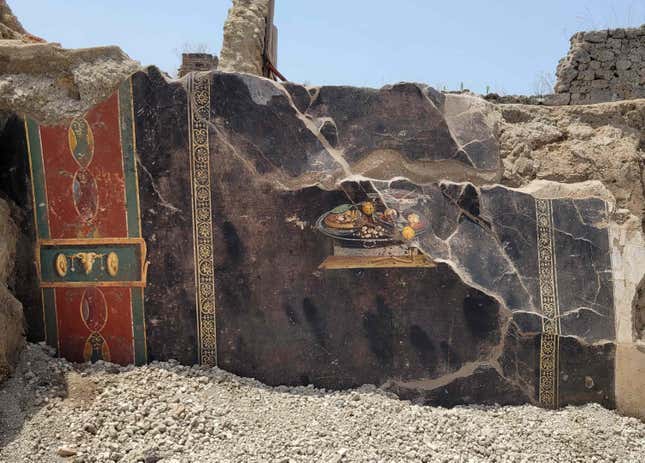Archaeologists excavating the ancient city of Pompeii have uncovered a gorgeous still-life fresco depicting a platter covered in food and wine, including one foot item that looks suspiciously like a pizza.
Reader: It’s not a pizza. Traditional pizza has tomato and mozzarella on it, as the Pompeii Archaeological Park press office reminded us in a statement released today. Rather, the bready item on the left side of the 2,000-year-old fresco is mensa, a Roman flatbread which served as both a platter for food and food itself.
Advertisement
In a blog describing the find, the culinary archaeologist Farrell Monaco noted that mensa is also Latin for table, and that the poet Virgil described eating the meal in The Aeneid: “After Aeneas and his men eat their meals off the flatbread, they remark, ‘Oh, look! We are eating our tables too!’”
The food “could be a distant ancestor of the modern dish,” the Pompeii press office noted in the release. According to the statement, the flatbread is loaded with a pomegranate, a possible date, as well as spices and condiments. Dried fruits and a goblet of wine also sit on the depicted platter. A research paper describing the find was published on the Pompeii website.
Advertisement
Advertisement
The food porn fresco was discovered in the Inula 10 of Pompeii’s Regio IX, just east of the city’s bustling center. Pompeii sits about 15 miles southeast of the modern city of Naples, Italy, which is generally considered the modern birthplace of pizza. Pompeii—now an archaeological site—was erased from maps in 79, when a violent eruption of Mount Vesuvius buried the city in ash.

Rediscovered in the 18th century, the city—once a bustling and beautiful hub of Roman life—was left immaculately preserved as a result of the eruption. Plates still sitting on tables gave archaeologists a window into middle-class Roman life, while the grisly remains of the city’s residents have provided insights into their dying moments and even their genetic codes.
Indeed, ancient food (not just murals of the stuff) have previously been excavated from Pompeii; in 2021, archaeologists revealed a preserved thermopolium, or Roman snack bar, with animal remains and bean residue still sitting in the dolia that held vendors’ wares.
Advertisement
Like the recently discovered fresco, the thermopolia of Pompeii had beautiful painted frescoes that were preserved under the volcanic ash for nearly 2,000 years.
The flatbread fresco was found in the atrium of a house that was connected to a bakery in Pompeii. The structure was partially explored between 1888 and 1891, but is only now being excavated thoroughly, with all the technological innovations of modern archaeology.
Advertisement
About 22 hectares (54 acres, or about one third of the town) remains totally buried under Vesuvius’ outlay. A daunting task, some might say, but for archaeologists, it’s a fantastic opportunity to see life frozen in time.
More: The Coolest Archaeological Discoveries of 2022
Services Marketplace – Listings, Bookings & Reviews